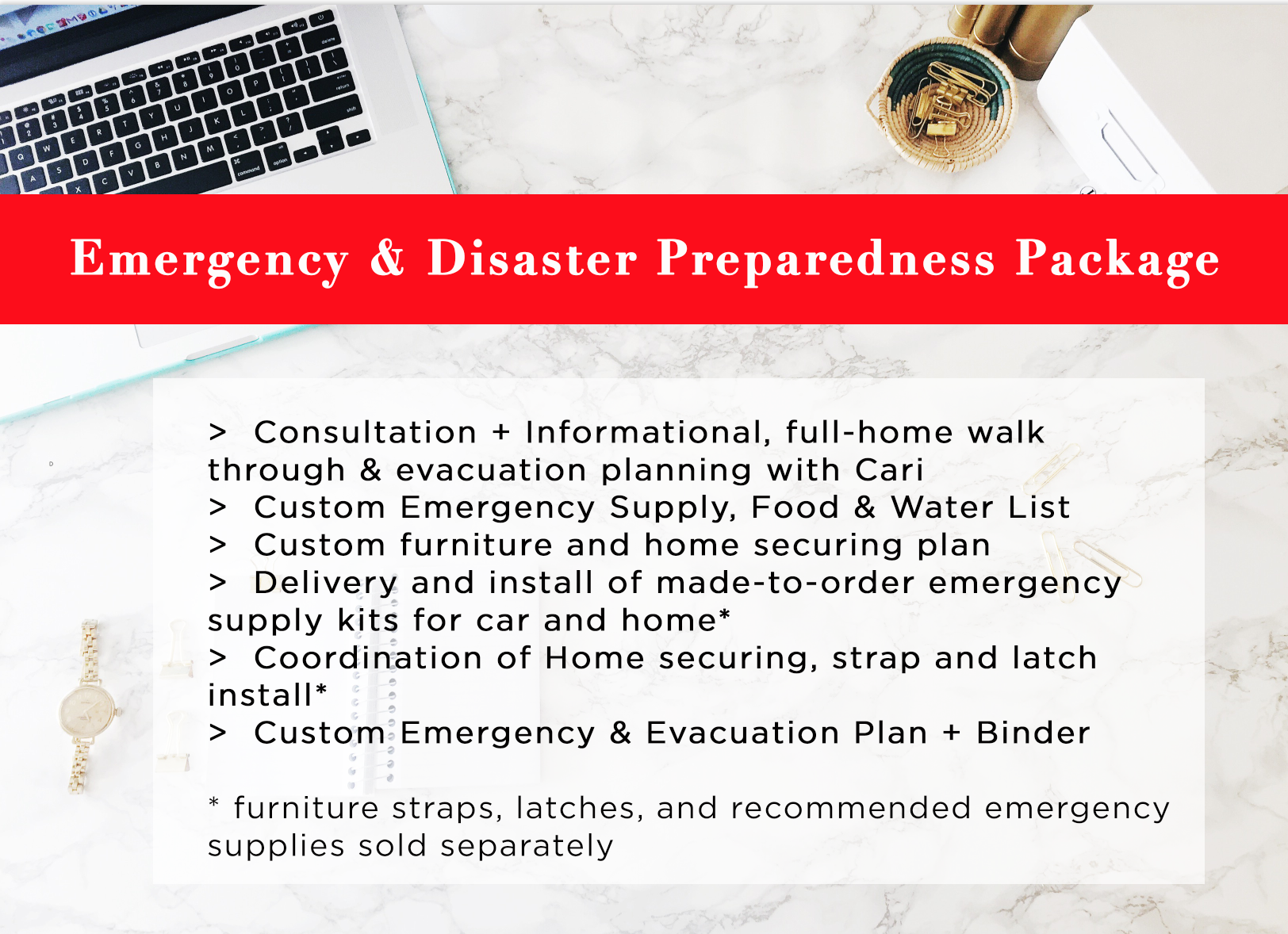Written by Cari Butler
.
We cannot predict, but we CAN prepare!
.
Do you have “getting prepared” on your New Year’s Resolution List? In my 15 years of being a Disaster Preparedness Expert and Consultant in Los Angeles, I have NEVER experienced such a need to be prepared! Case in point are the recent fires that have devastated Southern California. Additionally, experts predict that there is at least an 86% chance of a significant earthquake in Southern California within the next year and a half, which has the potential of wiping out Los Angeles power and water for up to 3 weeks! Can you imagine what that would mean for your home, family, and community?
.
So I ask you… if a disaster happened today, would YOU be prepared? For many of us, it’s an incredibly overwhelming task.
.
When my clients call me, most of them don’t even know where to begin, so they put it off, again and again! I assure them that it really is not as overwhelming as they might think. There are just 4 steps you need in order to begin to prepare:
.
STEP 1. PREPARE A KIT & SUPPLIES/DOCUMENTS:
.
It’s recommended that you have enough supplies on hand for at least 2-3 weeks. Here are the items to have ready at all times, in case of an emergency:
.
- An emergency kit should include food (canned and dried goods), water, first aid, search and rescue equipment, lighting, comfort and sanitation products to sustain each person for at least 2-3 weeks. Make sure to keep your emergency kit in a place that’s easily accessible, such as a coat closet or under your bed.
.
- Keep all your important documents, such as insurance (including medical, home and car), birth certificates, doctor’s name, medical records and passport in one place for easy access. We recommend a simple fireproof file box with a handle to grab on the go.
.
- Keep cash on hand in small bills. Keeping enough cash for 2-3 weeks in your fireproof file box and/or your car glove box is a great way to go.
.
- If you are on medication on a daily basis, make sure you have an extra prescription.
.
- If you wear glasses, have an extra pair in your emergency kit.
.
- Keep a pair of shoes under your bed.
.
- Have an out of state contact person in case of emergencies. Phone lines may go down, causing your ability to reach other cell phones with the same area code impossible. Calling someone out of state will allow them to reach out to others in your area on your behalf.
.
- Don’t forget your pets! Make sure you have plenty of food for them!
.
- Always have at least 1/2 a tank of gas in your car at all times.
.
STEP 2. PREPARE YOUR SPACE:
.
When I meet with clients, the MOST important thing for me is the safety of their home and family. We literally walk from room to room identifying “red flags” and discussing solutions to any potential dangers. One of the most important things to do is secure large pieces of furniture to the wall. My clients often say, “oh this armoire is so heavy, it’s not going anywhere.” What they don’t realize is that it is NOT the furniture that moves in an earthquake, it’s the GROUND! Imagine a table in your child’s playroom covered with blocks. Now imagine shaking the table. ALL of the blocks will move or fall down! If the earth is the table, your furniture is those blocks.
.
Make sure to secure furniture to the wall if it:
.
- Is taller than it is wide
.
- Is attached to gas
.
- Can block an entrance or an exit
.
- Can do extreme bodily harm if it falls (i.e. refrigerator)
.
STEP 3. CREATE A PLAN:
.
When making a plan, it is important to include your entire family, including any caregivers for your children. Make sure that you plan on sharing responsibilities and work together as a team.
.
Discuss the types of disasters that are most likely to happen in your community. Explain what to do in each case, (e.g., earthquake, fire, and severe weather).
.
Your family may not be together when a disaster strikes, so make sure you plan how you will contact one another. Cell phones might not be working so it is extremely important to have an out of town contact who knows your plan. Review what you will do in different situations, and make sure it’s written down in one central location.
.
STEP 4. PRACTICE YOUR PLAN:
.
Making an evacuation plan with your family is not enough. Discuss it and practice it once every 6 months to a year, to make sure everyone can confidently follow it when there’s a need. This is especially important for kids because it empowers them rather than scares them. A practiced plan is important because if there is a situation where you do need to leave your home, everyone can remain calm because everyone knows his or her job!
.
There are so many misconceptions about earthquakes. There is not a specific time that earthquakes happen, nor is there Earthquake Weather!
.
That’s why I’m passionate about preparing and educating families and setting up all the necessary tools and plans needed to respond to an emergency with clarity.
.
(BONUS) 5. WORK WITH US:
.
Cari Butler and Simply Spaced are partnering up to offer full-service Emergency Preparedness to LA residents! We’re thrilled to bring this invaluable service to our clients. Sign up today, for the special Emergency & Disaster Preparedness Package below. Email us at hello@simplyspaced.com to book your consultation!
.

.
 About the Author: Emergency Preparedness Expert Cari Butler has over 15 years of teaching experience. She is a Westside Los Angeles mom whose interest in Emergency Preparedness began when her daughter started school and was required to have a personal emergency kit. That raised the question: “Why shouldn’t everyone have an emergency kit?” Her concern led her to thoroughly research the subject and create her own business and is the only Angeleno to offer these emergency preparedness consultations and services. Cari provides personalized consultation services for families and businesses, as well as offers customized emergency preparedness kits.
About the Author: Emergency Preparedness Expert Cari Butler has over 15 years of teaching experience. She is a Westside Los Angeles mom whose interest in Emergency Preparedness began when her daughter started school and was required to have a personal emergency kit. That raised the question: “Why shouldn’t everyone have an emergency kit?” Her concern led her to thoroughly research the subject and create her own business and is the only Angeleno to offer these emergency preparedness consultations and services. Cari provides personalized consultation services for families and businesses, as well as offers customized emergency preparedness kits.